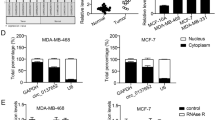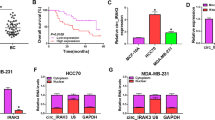Abstract
Background
Circular RNAs (circRNAs) and microRNAs (miRNAs) are closely associated with tumorigenesis. Breast cancer is a heterogeneous disease with subtypes. It is one of the leading causes of death in women, and dysregulation of various circRNAs and miRNAs are involved in the development of breast cancer. Furthermore, circPGPEP1(hsa_circ_0050102) could function as a tumor promoter. However, the potential mechanisms of circPGPEP1-modulated signaling in breast cancer are still unknown.
Objective
The aim of this study was to identify the detailed roles of circPGPEP1 during tumor progression. The expression profiles of circPGPEP1 and miR-30b in breast cancer tissues and cells were examined using RT-qPCR. The protein levels of ITGB3 in MCF-7 and T47D cells transfected with miR-30b mimics were determined by western blotting. Additionally, the proliferation, invasion and migration of transfected breast cancer cells were evaluated using CCK8 and Transwell assays. Moreover, the apoptotic rates of treated cancer cells were measured by flow cytometry. Luciferase reporter assay was used to explore the interaction between miR-30b and circPGPEP1/ITGB3.
Results
Our results revealed upregulation of circPGPEP1 in breast cancer tissues and cell lines, which was associated with poor prognosis in the patients. Knockdown of circPGPEP1 inhibited the proliferation, invasion and migration of cancer cells, while cell apoptosis was promoted. The expression of miR-30b was increased but the levels of ITGB3 were decreased following the knockdown of circPGPEP1. Furthermore, miR-30b was negatively correlated with circPGPEP1 and ITGB3 in breast cancer tissues. In addition, miR-30b mimics suppressed the growth of breast cancer cells, whereas cell apoptosis was enhanced. These effects were reversed by the overexpression of ITGB3. Furthermore, miR-30b mimics could abrogate the biological behavior changes caused by oe-circPGPEP1.
Conclusion
CircPGPEP1 could function as a tumor promoter by targeting miR-30b and ITGB3. The circPGPEP1/miR-30b/ITGB3 axis may regulate the proliferation, invasion, migration and apoptosis of breast cancer cells, which could be novel prognostic and therapeutic target.






Similar content being viewed by others
Data availability
The datasets generated during and/or analysed during the current study are available from the corresponding author upon reasonable request.
References
Adam-Artigues A, Garrido-Cano I, Simon S, Ortega B, Moragon S, Lameirinhas A, Constancio V, Salta S, Burgues O, Bermejo B, Henrique R, Lluch A, Jeronimo C, Eroles P, Cejalvo J (2021) Circulating miR-30b-5p levels in plasma as a novel potential biomarker for early detection of breast cancer. ESMO Open 6(1):100039
Britt KL, Cuzick J, Phillips K (2020) Key steps for effective breast cancer prevention. Nat Rev Cancer 20:417–436
Burstein HJ (2020) Systemic therapy for estrogen receptor-positive, HER2-negative breast cancer. New Engl J Med 383:2557–2570
Croset M, Pantano F, Kan C, Bonnelye E, Descotes F, Alix-Panabieres c, Lecellier C, Bachelier R, Alllioli N, Hong S, Bartkowiak K, Pantel K, Clezardin P: miRNA-30 Family members inhibit breast cancer invasion, osteomimicry, and bone destruction by directly targeting multiple bone metastasis–associated genes. Cancer Res 78: 5259-5273, 2018
Di Timoteo G, Dattilo D, Centrón-Broco A, Colantoni A, Guarnacci M, Rossi F, Incarnato D, Oliviero S, Fatica A, Morlando M, Bozzoni I (2020) Modulation of circRNA Metabolism by m6A Modification. CELL REP 31:107641
Dubsky P, Pinker K, Cardoso F, Montagna G, Ritter M, Denkert C, Rubio I, Azambuja E, Curigliano G, Gentilini O, Gnant M, Gunthert A, Hauser N, Heil J, Knauer M, Knotek-Roggenbauerc M, Knox S, Kovacs T, Kuerer H, Loibl S, Mannhart M, Meattini I, Penault-Llorca F, Radosevic-Robin N, Sager P, Spanic T, Steyerova P, Tausch C, Peeters M, Weber W, Cardoso M (2021) Poortmans P : Breast conservation and axillary management after primary systemic therapy in patients with early-stage breast cancer: the Lucerne toolbox. Lancet Oncol 22:e18–e28
Estevao-Pereira H, Lobo J, Salta S, Amorim M, Lopes P, Cantante M, Reis B, Antunes L, Castro F, Palma de Sousa S, Goncalves C, Costa B, Henrique R, Jeronimo C: Overexpression of circulating MiR-30b-5p identifies advanced breast cancer. J Trans Med 17(1): 435, 2019
Fuentes P, Sesé M, Guijarro P, Emperador M, Sanchez-Redondo S, Peinado H, Hummer S, Cajal S (2020) ITGB3-mediated uptake of small extracellular vesicles facilitates intercellular communication in breast cancer cells. Nat Commun 11:4261
Gao D, Zhou Z, Huang H (2019) miR-30b-3p inhibits proliferation and invasion of hepatocellular carcinoma cells via suppressing PI3K/Akt pathway. Front Genet 10:1247
Guan B, Li Q, Zhang H, Yang H (2021) circ_NOTCH3 Functions as a Protooncogene Competing With miR-205-5p, Modulating KLF12 Expression and Promoting the Development and Progression of Basal-Like Breast Carcinoma. FRONT ONCOL 10:602694
Harbeck N, Penault-Llorca F, Cortes J, Gnant M, Houssami N, Poortmans P, Ruddy K, Tsang J, Cardoso F (2019) Breast Cancer Nat Rev Dis Primers 5:66
Hua S, Gao J, Li T, Wang M, You L, Chen G, Han X, Liao Q: The promoting effects of hsa_circ_0050102 in pancreatic cancer and the molecular mechanism by targeting miR-1182/NPSR1. CARCINOGENESIS, 2020.
Huang X, Huang Z, Huang J, Xu B, Huang X, Xu Y, Zhou J, Tang Z (2020) Exosomal circRNA-100338 promotes hepatocellular carcinoma metastasis via enhancing invasiveness and angiogenesis. J Exp Clin Canc Res 39:20
Li Y, Song Y, Li P, Li M, Wang H, Xu T, Yu X, Yu Y, Tai Y, Chen P, Cai X, Wang X, Xiang L, Deng R, Zhang X, Gao L, Wang X, Liu J, Cao F (2019) Downregulation of RIG-I mediated by ITGB3/c-SRC/STAT3 signaling confers resistance to interferon-α-induced apoptosis in tumor-repopulating cells of melanoma. J Immunother Cancer 8:e111
Li X, Ding J, Wang X, Cheng Z, Zhu Q (2020) NUDT21 regulates circRNA cyclization and ceRNA crosstalk in hepatocellular carcinoma. Oncogene 39:891–904
Reich D, Kresinsky A, Müller JP, Bauer R, Kallenback J, Schnoeder T, Heidel F, Fassler R, Mann M, Bohmer F, Jayavelu A (2020) SHP1 regulates a STAT6–ITGB3 axis in FLT3ITD-positive AML cells. Leukemia 34:1444–1449
Shafabakhsh R, Mirhosseini N, Chaichian S, Moazzami B, Mahdizadeh Z, Asemi Z (2019) Could circRNA be a new biomarker for pre-eclampsia? Mol Reprod Dev 86:1773–1780
Shi Y, Jia X, Xu J (2020) The new function of circRNA: translation. Clin Transl Oncol 22:2162–2169
Wang J, Zhao X, Wang Y, Ren F, Sun D, Yan Y, Kong X, Bu J, Liu M, Xu S (2020) circRNA-002178 act as a ceRNA to promote PDL1/PD1 expression in lung adenocarcinoma. Cell Death Dis 11:32
Wang Y, Liu X, Wang L, Zhang Z, Li Z and Li M: Circ_PGPEP1 Serves as a Sponge of miR-1297 to Promote Gastric Cancer Progression via Regulating E2F3. DIGEST DIS SCI, 2021a.
Wang Y, Wang C, Fu Z, Zhang S, Chen J: miR-30b-5p inhibits proliferation, invasion, and migration of papillary thyroid cancer by targeting GALNT7 via the EGFR/PI3K/AKT pathway. Cancer cell international, 2021b.
Wu P, Mo Y, Peng M, Tang T, Zhong Y, Deng X, Xiong F, Guo C, Li Y, Li X, Li G, Zeng Z, Xiong W (2020a) Emerging role of tumor-related functional peptides encoded by lncRNA and circRNA. Mol Cancer 19:22
Wu Q, Zhong H, Jiao L, Wen Y, Zhou Y, Zhou J, Lu X, Song X, Ying B (2020b) MiR-124-3p inhibits the migration and invasion of Gastric cancer by targeting ITGB3. Pathol—Res Practice 216:152762
Wu T, Song H, Xie D, Hua K, Hu J, Deng Y, Ji C, Fang L (2020c) Mir-30b-5p promotes proliferation, migration, and invasion of breast cancer cells via targeting ASPP2. Biomed Res Int 1–12:2020
Xu J, Ji L, Liang Y, Wan Z, Zheng W, Song X, Gorshkov K, Sun Q, Lin H, Zheng X, Chen J, Jin R, Liang X, Cai X (2020) CircRNA-SORE mediates sorafenib resistance in hepatocellular carcinoma by stabilizing YBX1. Signal Transduct Target Ther 5:298
Zhang Q, Liu S, Zhang J, Ma X, Dong M, Sun B, Xin Y: Roles and regulatory mechanisms of miR-30b in cancer, cardiovascular disease, and metabolic disorders (Review). Exp Therapeutic Med. 2020.
Zhang H, Ge Z, Wang Z, Gao Y, Wang Y and Qu X: Circular RNA RHOT1 promotes progression and inhibits ferroptosis via mir-106a-5p/STAT3 axis in breast cancer. Aging 13, 2021.
Zhou J, Xiang A, Guo J, Cui H (2019) miR-30b suppresses the progression of breast cancer through inhibition of the PI3K/Akt signaling pathway by targeting Derlin-1. Trans Cancer Res 8(1):180–190
Zhu C, Kong Z, Wang B, Cheng W, Wu A, Meng X (2019) ITGB3/CD61: a hub modulator and target in the tumor microenvironment. Am J Transl Res 11:7195–7208
Acknowledgements
The authors express their sincere thanks to the seniors and colleagues for providing adequate guidance, scientific and technical discussions and necessary support for this research article. The first author and the co-author acclaim the reviewers and editor for their valuable comments and suggestions.
Funding
Not applicable.
Author information
Authors and Affiliations
Contributions
Both authors designed the study and carried out the experiments. They both analyzed the data and drafted the manuscript.
Corresponding author
Ethics declarations
Conflict of interest
Yongjia Tan declares that she has no conflict of interest. Xiang Wang declares that he has no conflict of interest.
Ethical approval
This study was approved by the Ethics Committee of the Third Affiliated Hospital of Chongqing Medical University (Chongqing, China).
Additional information
Publisher's Note
Springer Nature remains neutral with regard to jurisdictional claims in published maps and institutional affiliations.
Rights and permissions
Springer Nature or its licensor (e.g. a society or other partner) holds exclusive rights to this article under a publishing agreement with the author(s) or other rightsholder(s); author self-archiving of the accepted manuscript version of this article is solely governed by the terms of such publishing agreement and applicable law.
About this article
Cite this article
Tan, Y., Wang, X. CircPGPEP1 promotes the growth and metastasis of breast cancer cells by targeting miR-30b. Mol. Cell. Toxicol. (2023). https://doi.org/10.1007/s13273-023-00376-9
Accepted:
Published:
DOI: https://doi.org/10.1007/s13273-023-00376-9




